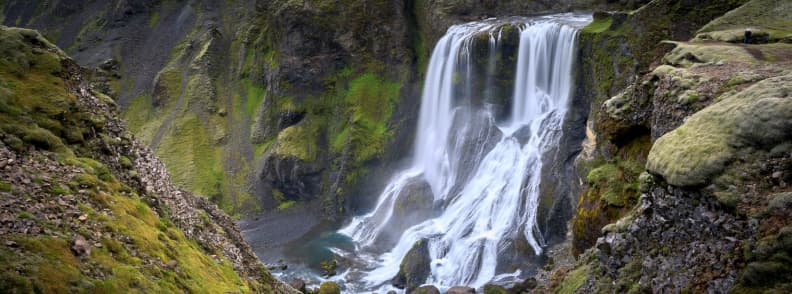For anyone planning a scenic trip to Iceland to take in the stunning sights and sounds, they’ll be pleased to hear that this beautiful region has an incredible assortment of natural landmarks and environments. Some of the most appealing are the waterfalls in Iceland and in this post, we’ll be telling you about 3 of the most captivating, all of which can be easily traveled to by car and then explored on foot for your enjoyment.
What is a waterfall?
A waterfall is a natural feature where water flows over a vertical drop in the course of a stream or river. They are a testament to the raw power of nature, offering breathtaking views and a sense of wonder.
How are waterfalls formed?
Waterfalls are formed when the riverbed changes abruptly from hard rock to soft rock. The softer rock erodes more quickly, creating a drop. Over time, this drop becomes steeper and the waterfall more dramatic.
The different types of waterfalls in Iceland
Iceland is home to a variety of waterfall types, from plunging falls that drop straight down from a height, to cascading falls that tumble over a series of rock steps. Each one is unique, offering a different spectacle of nature’s power.
Let’s talk about plunging waterfalls – the daredevils of the waterfall world. These falls are not afraid of heights, but rather, they embrace them. They cascade straight down from towering cliffs, creating a mesmerizing sight as the water freefalls into the pool below. A great example of this type of waterfall is the mighty Dettifoss, known as the most powerful waterfall in Europe. Its thunderous roar and the misty spray that rises from its base are truly awe-inspiring.
Moving on, we come to the cascading waterfalls – the magnificent, multi-tiered wonders of the waterfall realm. These falls gracefully flow over a series of rock steps, producing a breathtaking sequence of smaller falls that come together to form a stunning spectacle. The Gullfoss waterfall serves as an excellent illustration of this kind of waterfall. It’s a two-tiered waterfall that pours into a deep, narrow canyon, putting on a captivating demonstration of nature’s might.
There are also waterfalls known as horsetail falls, which are quite graceful. These falls remain in contact with the bedrock as they fall, creating a shape that resembles the tail of a horse. Seljalandsfoss, one of Iceland’s most well-known waterfalls, is a horsetail waterfall. What makes it unique is that you can walk behind it, providing a one-of-a-kind perspective and a truly immersive experience.
Finally, we come to the block waterfalls, which are wider than they are tall, producing a magnificent curtain of water. Skógafoss is a prime illustration of a block waterfall. This Icelandic waterfall is among the largest, measuring 25 meters in width and dropping 60 meters. It is truly a breathtaking sight to behold.
The history of waterfalls in Iceland
Iceland’s waterfalls have been shaped by the country’s unique geology and climate. The island’s volcanic activity and glacial meltwater contribute to the formation of these stunning features. They have been a part of Icelandic folklore and history, often serving as landmarks and sources of power.
The best waterfalls in Iceland
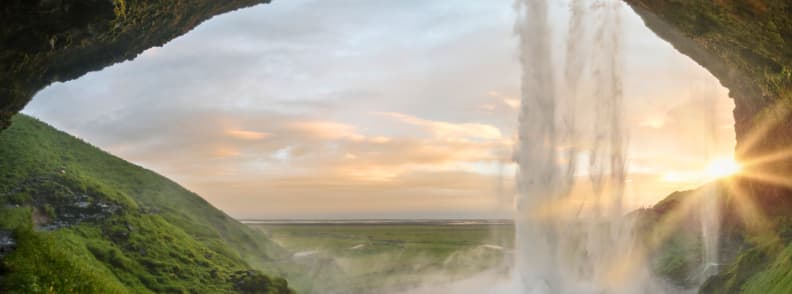
1. Seljalandsfoss
Not only is the name of this waterfall a little tricky to pronounce, but it can also be confusing to get to as well and that’s why so many opt to hire a vehicle from Reykjavik Cars, where you’ll be able to drive yourself to this destination easily and in the comfort of your very own mode of transport. This waterfall is in the southern part of Iceland, close to Route 1, and has a huge 60-meter drop – which is best viewed from a safe distance.
2. Gullfoss Falls
If the idea of visiting a natural landmark that could make the ideal scene for an Instagram story appeals to you, the Gullfoss Falls could be the perfect place to visit. This collection of waterfalls ranges from small to large, and the stunning sound of rushing water has been used in media time and time again. It’s also considered one of the most famous waterfalls in the entirety of Iceland and promises beautiful views and captivating memories for everyone that visits.
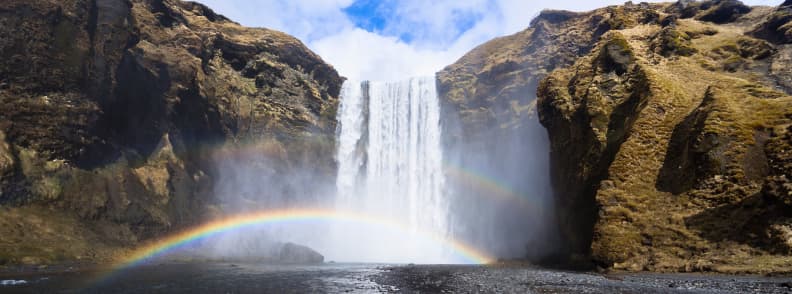
3. Skógafoss
Skógafoss is one of the biggest and most beautiful waterfalls in the country with a width of 25 meters and a drop of 60 meters.
4. Dettifoss
Dettifoss, located in Vatnajökull National Park in Northeast Iceland, is reputed to be the most powerful waterfall in Europe.
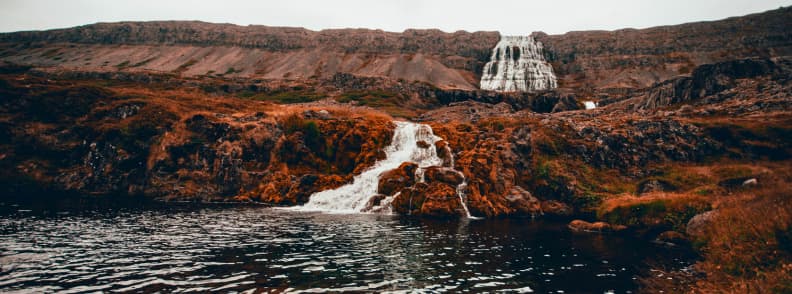
5. Dynjandi
Dynjandi, also known as Fjallfoss, is a series of waterfalls located in the Westfjords. The waterfalls have a cumulative height of 100 meters.
6. Goðafoss
Goðafoss, the ‘Waterfall of the Gods’, is one of the most spectacular waterfalls in Iceland. It’s closely connected with one of the most dramatic events in Icelandic history – the conversion to Christianity.
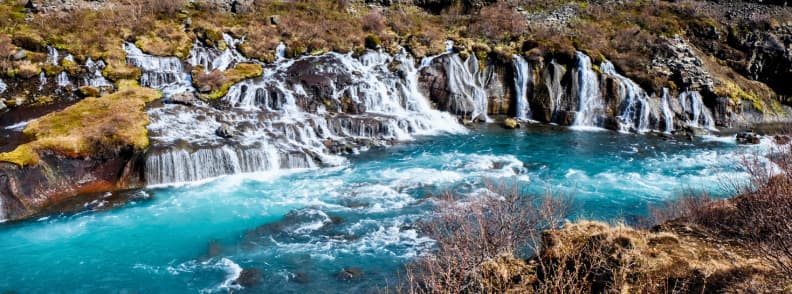
7. Hraunfossar
Hraunfossar, or Lava Falls, is a series of waterfalls formed by rivulets streaming over a distance of about 900 meters out of the Hallmundarhraun lava field.
8. Selfoss
Located near the mighty Dettifoss, Selfoss is a beautiful waterfall that often gets overlooked by tourists. It’s a serene spot that’s worth a visit.
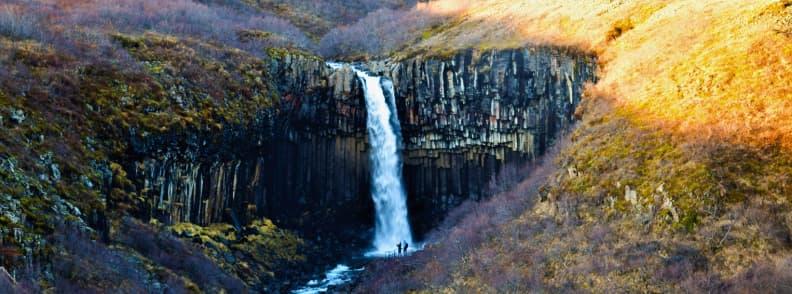
9. Svartifoss
Svartifoss, or Black Falls, is surrounded by dark lava columns, which give it its name. These basalt columns have inspired Icelandic architects, most visibly in the Hallgrímskirkja church in Reykjavík.
10. Haifoss
When most people think about a waterfall, they are often greeted by the image of a huge cliff face with a steep incline and water that runs out and down into a pool below. That’s exactly what Haifoss is, in fact, it’s such an iconic location that it truly has to be seen to be believed. The actual drop measures roughly 122 meters, making it one of the largest waterfalls in Iceland, with a flow of water that runs for the entire year, making any time a great time to visit.
How to get to the best waterfalls in Iceland
By car
Renting a car and driving yourself is the most convenient way to see the waterfalls. It gives you the freedom to explore at your own pace.
By bus
There are bus tours that take you to the most popular waterfalls. This is a good option if you prefer not to drive.
By plane
Some waterfalls are located near domestic airports and can be reached quickly by plane from Reykjavík.
By boat
In the summer, boat tours are available to some waterfalls that are otherwise inaccessible.
Where to stay near the best Waterfalls in Iceland
Vik
Vik is a small village located near Skógafoss and Seljalandsfoss. It offers a range of accommodations, from hostels to luxury hotels.
Selfoss
The town of Selfoss, located near the waterfall of the same name, offers a variety of accommodations and is a great base for exploring the Golden Circle.
Jokulsarlon
Near the glacier lagoon Jökulsárlón, there are several guesthouses and a campground.
Akureyri
Akureyri, close to Goðafoss and Dettifoss, is the largest town in North Iceland and offers a wide range of accommodations.
Tips for visiting waterfalls in Iceland
When to go
The best time to visit depends on what you want to see. In summer, you’ll experience the midnight sun, while winter offers the chance to see the Northern Lights.
What to wear
Dress in layers and be prepared for all weather conditions. Waterproof clothing is recommended as you may get wet from the spray of the waterfalls.
What to bring
Don’t forget your camera! Also, bring a water bottle, snacks, and a good pair of hiking boots if you plan to do some walking.
How to stay safe
Stay on marked paths and respect safety signs. Also, be aware that the rocks around waterfalls can be slippery.
Ready to uncover the best waterfalls in Iceland?
Iceland is by far one of the most tranquil, natural parts of the world, and with so much of it untouched by people, it often becomes one of the most memorable places for visitors. Although many simply book a stay to be able to say that they’ve visited Iceland, so many end up coming back because they fall in love with the region, from its idyllic waterfalls to its friendly residents and variety of things to see and do – Iceland isn’t just a holiday destination, it’s a demonstration of just how beautiful the world can be.

Coming from Romania and currently residing in the picturesque South of France, Mirela Letailleur is a seasoned travel enthusiast with a knack for uncovering Europe’s hidden gems. Her platform, The Travel Bunny, is a treasure trove of practical advice and insider tips for budget-conscious explorers. Mirela’s unique approach to travel, coupled with her expertise in crafting comprehensive, free travel guides, sets her apart in the realm of travel blogging. Her knack for problem-solving and her aspiration to become a coffee connoisseur add a personal touch to her professional persona.
When it comes to the majestic waterfalls of Iceland, there’s no one better equipped to guide you than Mirela. Her in-depth knowledge of the terrain, coupled with her local expertise, makes her the go-to source for all things related to Iceland’s waterfalls. Whether you’re seeking the thunderous spectacle of Dettifoss or the serene beauty of Seljalandsfoss, Mirela’s insights will ensure you experience the best of what Iceland has to offer. Trust in Mirela’s expertise and let The Travel Bunny guide you on your next Icelandic adventure.
After exploring the best waterfalls in Iceland, check out these travel blog posts
Essential things every single woman should do on their next Iceland vacation
The most amazing day trips from Reykjavik
Best travel tips visit Iceland on a budget

